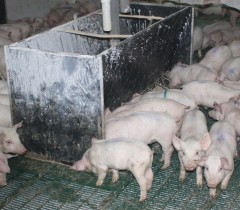RESEARCH: Finding ways to feed pigs for less

Results of a preliminary experiment conducted at the University of Illinois indicate that it may be possible to select pigs that can make efficient use of energy in less expensive feed ingredients, thus reducing diet costs.
Less expensive feed is usually higher in fibre than the corn-soy diets typically used in US swine production, explained Hans H. Stein, professor of animal sciences at the University of Illinois at Urbana-Champaign.
However, the white breeds that are used in commercial pork production use only about 40% of the insoluble fibre. “If you can increase that number to 50 or 60 or 70%, then of course, you would get a much better use of the energy in those ingredients,” Stein explained.
“The white breeds have been selected for high efficiency and rapid gain for many, many generations,” Stein continued. “But that’s all based on corn-soy diets.
“However, there are also indigenous breeds of pigs that have not been selected for commercial production, and these breeds have, therefore, not been fed the corn-soybean meal diets for as many generations as the white breeds.”
Meishan pigs
Among those indigenous breeds are Meishan pigs, which have been raised in China for many centuries. Stein’s hypothesis was that these pigs, which have not been selected for efficiency and rapid weight gain, would use fibre more efficiently than the white breeds.
Stein and his team compared the fibre digestion of Meishan pigs with that of two groups of Yorkshire pigs.
They tested four diets that used high-fibre ingredients: distillers dried grains with solubles (DDGS), soybean hulls, sugar beet pulp, and pectin.
When fed DDGS, the values for apparent total tract energy digestibility were higher for the Meishan pigs (83.5%) than for either weight-matched (77.3%) or age-matched (78.8%) Yorkshire pigs.
Researchers observed no significant difference in energy digestibility for the other ingredients.
“What we observed was that, particularly for the DDGS diets, the Meishans were quite a bit more effective at using that fibre,” Stein said. “That diet is high in insoluble dietary fibre. When we looked at more soluble fibres, there was no difference.”
Although Meishan pigs would never be used for commercial pork production in the United States, the results indicate that differences exist among breeds of pigs.
Differences in pig breeds
Thus, it is possible that differences also exist among the white breeds and that some may use fibres more efficiently than others.
Stein stressed that this study was preliminary and said that determining if white breeds can be bred to use insoluble fibre more efficiently will be quite costly because it requires selecting pigs for multiple generations.
Stein said that he and colleagues at the University of Illinois’ Institute for Genomic Biology are pursuing funding for further research.
“I think it is exciting that there are some pigs that can use fibre better than we have thought in the past, and I think this will open up opportunities to think in different ways about how we can feed pigs economically,” he said.
The study was published in a recent issue of the Journal of Animal Science and was co-authored with former graduate student Pedro Urriola.











